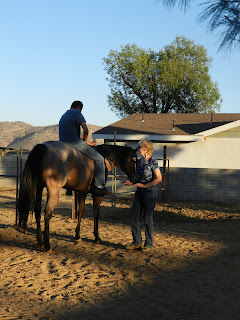These are special Zucchini, the reason they are special is because I grew them. Just kidding. It is because I grew them for a friend of mine. She loves giant ones for the BBQ grill. The beauty above is over 5 lbs. I like mine smaller but for the grill these are actually great.
So the one with my daughters hand on it is the 5 pounder and the smaller one is almost 4 1/2 lbs. Both went to my friend.
This one is almost 18 inches long too.
On to Blossom End Rot, found this poor soul hanging on, clinging to life. This is fatal. Yes he is going to die a horrible death. I read that Blossom End Rot is a lack of Calcium in the soil, but my dear friend Agrarian told me this before I had read anything. She had had this happen to her zucchini too. I will copy some info from the internet for you, in case you have this problem in the future. I have not seen any others suffer this fate yet. I will be crushing up some egg shells and amending them into the soil. I will also add some coffee grounds too.
Here is some info from the internet that I found, hope it helps you.
Blossom End Rot is the result of a lack of calcium in the zucchini plant. This article discusses what to do about blossom end rot and yellowing in zucchini.
Why does my zucchini rot?
Blossom End Rot is a disease common to zucchini, which causes the blossom end of the fruit to rot. Per Clemson University, “The main symptom is a dark-colored dry rot of the blossom end of the fruit. Blossom-end rot is caused by a lack of calcium in the developing fruit.” So either the plant is not absorbing enough calcium from the soil or the soil doesn’t have enough calcium in it to start with. The solution is to get a PH soil test kit and test your soil. If it is lacking calcium, the solution would be to add calcium to your soil. Dolomitic lime supplies calcium (Ca) as well as Magnesium (Mg) to your soil. It also increases the microbial activity necessary to break down nitrogen into ammonium for absorption by your plant's roots.
If the test shows the soil is okay, then you can increase nutrient uptake to the roots of the plant by mulching and adding compost/organic matter to your soil (sheep, poultry, cattle or pork manure has the best carbon to nitrogen ratio), and by watering well.
What causes yellowing in zucchini?
Yellowing is usually caused by a lack of Nitrogen, which can be helped by adding nitrogen-rich compost, or by adding lime, or by adding manure. Many agriculture experts have advised amending soil with lime for nitrogen deficiency. There is an issue with organic fertilizers needing to be broken down by microorganisms in the soil before the plant can absorb the nutrients properly. The nitrogen gets "tied up" in this process and does not get absorbed by your plant quickly enough, so it's often recommended to use an inorganic nitrogen application along with your organic fertilizer. Again, the best solution is to do a soil test so you’ll be able to eliminate what it is NOT.
If the carbon to nitrogen (C:N) ratio of the organic fertilizer is less than about 20:1, "then microorganisms will obtain adequate nitrogen for their needs and will convert the excess organic nitrogen to ammonium (NH4+). This conversion is called mineralization." (See Colorado State link above) Ammonium is a form of nitrogen plants CAN absorb. Carbon acts like a furnace or energy source to speed this conversion process. Sheep, beef, swine or poultry manure supplies the necessary ratios; speeds up the microbial process; and gets the nutrients to your plants.
A common practice in vegetable gardening is to broadcast lime and other amendments onto the garden soil and mix it well into the dirt and let it rain on it a number of times before planting your plants. In the old days, people didn’t test the soil - they always just added the lime as a rule of thumb (right along with the 10-10-10) and they usually had a gorgeous garden. But you can achieve the same proper soil balance without the chemical fertilizer by using organic fertilizers, such as liquid fish fertilizer, complemented by rich compost and organic matter to speed mineralization.
Lack of Pollination
Another reason for rotting and shriveling zucchini is lack of pollination by bees.
HAVE A GREAT DAY!!!!!!!!!!!!!!!!
Tracey

















































.jpg)


